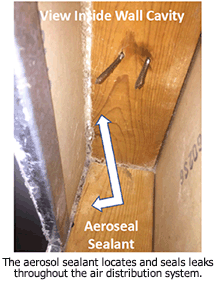New
Study Dispels Myth That Leaks In Interior Ductwork Do
Not Contribute To Home Energy Loss.
 Study
Shows That Sealing Ducts Located In Conditioned Space
Saved Up to 16% of Energy and Reduced Overall Home
Envelope Leakage By More Than 11%. Study
Shows That Sealing Ducts Located In Conditioned Space
Saved Up to 16% of Energy and Reduced Overall Home
Envelope Leakage By More Than 11%.
Comfort Institute released finding from a new study that
indicates leaks in ductwork located in conditioned space
can have a significant impact on energy savings. The
study, conducted by Comfort Institute in combination
with the Greater Cincinnati Energy Alliance (GCEA),
showed that the amount of conditioned air seeping
through the building envelope and escaping to the
outside of the home was reduced by an average of 11.4%
after the ducts were effectively sealed.
Energy
modeling conducted by the Greater Cincinnati Energy
Alliance showed an average total heating and cooling
cost of $2,010 per year, with $202 per year in savings
or a 10% reduction in energy costs.
“We now have some initial data which contradicts the
common opinion that duct sealing only saves energy if
the leaky ducts are located in unconditioned spaces,”
said Rob McCracken, Director of Operations for GCEA. “We
can begin to see that, based on individual home
situations, homes with duct systems located inside the
house can see a reduction in energy consumption between
5 percent to 15 percent.”
“There is an erroneous belief among many building
professionals that leaks within ductwork located inside
the home, have little effect on overall energy use,”
said Comfort Institute co-founder Brendan Reid. “Earlier
studies only addressed the impact of sealing duct leaks
which were readily accessible for hand sealing – those
in unfinished basements. What those studies neglected to
evaluate was the impact of sealing the hidden,
inaccessible duct leaks – which routinely do leak to
outside.”
Story
continues below ↓
|